Supercapacitor-Assisted Techniques and Supercapacitor-Assisted Loss Management Concept: New Design Approaches to Change the Roadmap of Power Conversion Systems
Abstract
:1. Introduction
2. Conventional Applications of Supercapacitors
3. Supercapacitor-Assisted Long-Time Constant Techniques for Non-Conventional Applications
4. Supercapacitor-Assisted Loss Management (SCALoM) Theory
4.1. Adding a Useful Load into Traditional RC Charging Loop
4.2. Inserting a Partially Charged Supercapacitor into the Charging Loop
4.3. Combining the Useful Load and the Partially Charged Supercapacitor in the Charging Loop
5. Validity and the Practical Application of the SCALoM Theory
5.1. Supercapacitor-Assisted Low-Dropout (SCALDO) Regulator
- By oversizing the SC, DC-uninterrupted power supply (DC-UPS) capability can be incorporated [62]
5.2. Supercapacitor-Assisted LED (SCALED) Converter
5.3. Supercapacitor-Assisted Surge Absorber (SCASA)
5.4. Wider Potential SCA Applications in Power Conversion
6. Conclusions
Author Contributions
Funding
Conflicts of Interest
References
- Karthikeyan, S.; Narenthiran, B.; Sivanantham, A.; Bhatlu, L.D.; Maridurai, T. Supercapacitor: Evolution and review. Mater. Today Proc. 2021. [Google Scholar] [CrossRef]
- Rani, J.R.; Thangavel, R.; Oh, S.I.; Lee, Y.S.; Jang, J.H. An Ultra-High-Energy Density Supercapacitor; Fabrication Based on Thiol-functionalized Graphene Oxide Scrolls. Nanomaterials 2019, 9, 148. [Google Scholar] [CrossRef] [Green Version]
- Hunter, C. Supercapacitors Can Challenge Tantalums on ESR; Endeavor business media, LLC: Nashville, TN, USA, 2006. [Google Scholar]
- Kim, Y. Ultracapacitor Technology Powers Electronic Circuits. Power Electron. Technol. 2003, 29, 34–39. [Google Scholar]
- Kularatna, N. Supercapacitors Improve the Performance of Linear Power-Management Circuits: Unique new design options when capacitance jump from micro-farads to farads with a low equivalent series resistance. IEEE Power Electron. Mag. 2016, 3, 45–59. [Google Scholar] [CrossRef]
- Kularatna, N.; Gunawardane, K. Energy Storage Devices for Renewable Energy-Based Systems; Academic Press: London, UK, 2021. [Google Scholar]
- Schneuwly, A.; Gallay, R. Properties and Applications of Supercapacitors From the State-of-the-art to Future Trends. In Proceedings of the PCIM 2000, Nuremberg, Germany, 6–8 June 2000. [Google Scholar]
- Rafik, F.; Gualous, H.; Gallay, R.; Crausaz, A.; Berthon, A. Frequency, thermal and voltage supercapacitor characterization and modeling. J. Power Sources 2007, 165, 928–934. [Google Scholar] [CrossRef]
- BU-410: Charging at High and Low Temperatures. Available online: https://batteryuniversity.com/learn/article/charging_at_high_and_low_temperatures (accessed on 28 May 2021).
- Supercapacitor Application Guidelines; Eaton: Cleveland, Ohio, USA, 2017.
- muRata Electrical Double Layer Capacitor (EDLC); Murata Manufacturing Co., Ltd: Kyoto, Japan, 2014.
- Sarno, M. Chapter 22—Nanotechnology in energy storage: The supercapacitors. In Studies in Surface Science and Catalysis; Basile, A., Centi, G., Falco, M.D., Iaquaniello, G., Eds.; Elsevier: Amsterdam, The Netherlands, 2020; Volume 179, pp. 431–458. [Google Scholar]
- Sudhakar, Y.N.; Selvakumar, M.; Bhat, D.K. Chapter 3—Biopolymer Electrolyte for Supercapacitor. In Biopolymer Electrolytes; Sudhakar, Y.N., Selvakumar, M., Bhat, D.K., Eds.; Elsevier: Amsterdam, The Netherlands, 2018; pp. 53–116. [Google Scholar] [CrossRef]
- Zhou, L.; Li, C.; Liu, X.; Zhu, Y.; Wu, Y.; van Ree, T. Chapter 7—Metal oxides in supercapacitors. In Metal Oxides in Energy Technologies; Wu, Y., Ed.; Elsevier: Amsterdam, The Netherlands, 2018; pp. 169–203. [Google Scholar] [CrossRef]
- Zhou, Z. Modeling and Power Control of a Marine Current Turbine System with Energy Storage Devices. Ph.D. Thesis, Universit´e de Bretagne Occidentale, Brest, France, 2014. [Google Scholar]
- Roth, W.-D. Super and Ultracapacitors Thousands of Farads Thanks to Double Layer Technology; EETech Media: Boise, ID, USA, 2019. [Google Scholar]
- Viswanathan, A.; Shetty, A.N. The high energy supercapacitor from rGO/Ni(OH)2/PANI nanocomposite with methane sulfonic acid as dopant. J. Colloid Interface Sci. 2019, 557, 367–380. [Google Scholar] [CrossRef]
- Li, L.; Wu, Z.; Yuan, S.; Zhang, X.-B. Advances and challenges for flexible energy storage and conversion devices and systems. Energy Environ. Sci. 2014, 7, 2101–2122. [Google Scholar] [CrossRef]
- Cheng, J.; Zhao, B.; Zhang, W.; Shi, F.; Zheng, G.; Zhang, D.; Yang, J. High-Performance Supercapacitor Applications of NiO-Nanoparticle-Decorated Millimeter-Long Vertically Aligned Carbon Nanotube Arrays via an Effective Supercritical CO2-Assisted Method. Adv. Funct. Mater. 2015, 25, 7381–7391. [Google Scholar] [CrossRef]
- Jiang, C.; Zhao, B.; Cheng, J.; Li, J.; Zhang, H.; Tang, Z.; Yang, J. Hydrothermal synthesis of Ni(OH)2 nanoflakes on 3D graphene foam for high-performance supercapacitors. Electrochim. Acta 2015, 173, 399–407. [Google Scholar] [CrossRef]
- Linzen, D.; Buller, S.; Karden, E.; Doncker, R.W.D. Analysis and evaluation of charge-balancing circuits on performance, reliability, and lifetime of supercapacitor systems. IEEE Trans. Ind. Appl. 2005, 41, 1135–1141. [Google Scholar] [CrossRef]
- Zhang, L.; Song, J.Y.; Zou, J.Y.; Wang, N. High Voltage Super-Capacitors for Energy Storage Devices Applications. In Proceedings of the 2008 14th Symposium on Electromagnetic Launch Technology, Victoria, BC, Canada, 10–13 June 2008; pp. 1–4. [Google Scholar]
- Barrade, P. Series Connection of Supercapacitors: Comparative Study of Solutions for the Active equalization of the Voltages. In Proceedings of the International Conference on Modeling and Simulation of Electric Machines, Converters and Systems, Montreal, QC, Canada, 18–21 August 2002; pp. 1–6. [Google Scholar]
- Muzaffar, A.; Ahamed, M.B.; Deshmukh, K.; Thirumalai, J. A review on recent advances in hybrid supercapacitors: Design, fabrication and applications. Renew. Sustain. Energy Rev. 2019, 101, 123–145. [Google Scholar] [CrossRef]
- Kularatna, N.; Fernando, J.; Kankanamge, K.; Zhang, X. A low frequency supercapacitor circulation technique to improve the efficiency of linear regulators based on LDO ICs. In Proceedings of the 2011 Twenty-Sixth Annual IEEE Applied Power Electronics Conference and Exposition (APEC), 6–11 March 2011; pp. 1161–1165. [Google Scholar]
- Saha, P.; Dey, S.; Khanra, M. Second-life applications of supercapacitors: Effective capacitance prognosis and aging. J. Power Sources 2021, 496, 229824. [Google Scholar] [CrossRef]
- Parvini, Y.; Siegel, J.B.; Stefanopoulou, A.G.; Vahidi, A. Supercapacitor Electrical and Thermal Modeling, Identification, and Validation for a Wide Range of Temperature and Power Applications. IEEE Trans. Ind. Electron. 2016, 63, 1574–1585. [Google Scholar] [CrossRef]
- Libich, J.; Máca, J.; Vondrák, J.; Čech, O.; Sedlaříková, M. Supercapacitors: Properties and applications. J. Energy Storage 2018, 17, 224–227. [Google Scholar] [CrossRef]
- Zhang, Y.; Mei, H.-X.; Cao, Y.; Yan, X.-H.; Yan, J.; Gao, H.-L.; Luo, H.-W.; Wang, S.-W.; Jia, X.-D.; Kachalova, L.; et al. Recent advances and challenges of electrode materials for flexible supercapacitors. Coord. Chem. Rev. 2021, 438, 213910. [Google Scholar] [CrossRef]
- Supercapacitors: Powering Next Generation Products. Available online: https://www.cap-xx.com/ (accessed on 2 May 2021).
- Dura Blue. Available online: https://www.maxwell.com/products/ultracapacitors/cells (accessed on 2 May 2021).
- Palma, L.; Enjeti, P.; Howze, J.W. An approach to improve battery run-time in mobile applications with supercapacitors. In Proceedings of the IEEE 34th Annual Conference on Power Electronics Specialist (2003 PESC’ 03), Acapulco, Mexico, 15–19 June 2003; Volume 912, pp. 918–923. [Google Scholar]
- Lukic, S.M.; Cao, J.; Bansal, R.C.; Rodriguez, F.; Emadi, A. Energy Storage Systems for Automotive Applications. IEEE Trans. Ind. Electron. 2008, 55, 2258–2267. [Google Scholar] [CrossRef]
- Allègre, A.; Bouscayrol, A.; Delarue, P.; Barrade, P.; Chattot, E.; El-Fassi, S. Energy Storage System With Supercapacitor for an Innovative Subway. IEEE Trans. Ind. Electron. 2010, 57, 4001–4012. [Google Scholar] [CrossRef]
- Thounthong, P.; Raël, S.; Davat, B. Energy management of fuel cell/battery/supercapacitor hybrid power source for vehicle applications. J. Power Sources 2009, 193, 376–385. [Google Scholar] [CrossRef]
- Lahyani, A.; Venet, P.; Guermazi, A.; Troudi, A. Battery/Supercapacitors Combination in Uninterruptible Power Supply (UPS). IEEE Trans. Power Electron. 2013, 28, 1509–1522. [Google Scholar] [CrossRef]
- Khan, N.; Mariun, N.; Zaki, M.; Dinesh, L. Transient analysis of pulsed charging in supercapacitors. In Proceedings of the 2000 TENCON Proceedings. Intelligent Systems and Technologies for the New Millennium (Cat. No.00CH37119), Kuala Lumpur, Malaysia, 24–27 September 2000; Volume 193, pp. 193–199. [Google Scholar]
- Srinivasan, R.; Mangalanathan, U.; Gandhi, U. Dual input buck-boost converter for hybrid piezoelectric energy harvester—Supercapacitor sources. AEU Int. J. Electron. Commun. 2019, 111, 152926. [Google Scholar] [CrossRef]
- Katayama, N.; Kogoshi, S. Frequency characteristic of a fuel cell-EDLC hybrid power source system with a multi-port bidirectional DC-DC converter. In Proceedings of the 8th International Conference on Power Electronics—ECCE Asia, Jeju, Korea, 30 May–3 June 2011; pp. 2561–2564. [Google Scholar]
- Hata, K.; Watanabe, N.; Sung, K. A series or parallel changeover system using battery with EDLC for EV. In Proceedings of the 2013 15th European Conference on Power Electronics and Applications (EPE), Lille, France, 2–6 September 2013; pp. 1–10. [Google Scholar]
- Ibañez, F.M.; Vadillo, J.; Echeverria, J.M.; Fontán, L. 100 kW bidirectional DC/DC converter for a supercapacitor stack. In Proceedings of the IEEE PES ISGT Europe 2013, Lyngby, Denmark, 6–9 October 2013; pp. 1–5. [Google Scholar]
- Plotnikov, I.; Polyakov, V.; Braslavsky, I. The Accounting a Incomplete Controllability in the Mathematical Model of Bidirectional DC-DC Converter for Frequency Controlled Electric Drive with Supercapacitors. In Proceedings of the 2018 International Symposium on Power Electronics, Electrical Drives, Automation and Motion (SPEEDAM), Amalfi, Italy, 20–22 June 2018; pp. 582–586. [Google Scholar]
- Hamasaki, S.; Yano, Y.; Fukuda, H.; Tsuji, M. Deadbeat control of bidirectional buck/boost DC-DC converter for power leveling system with EDLC. In Proceedings of the IECON 2015—41st Annual Conference of the IEEE Industrial Electronics Society, Yokohama, Japan, 9–12 November 2015; pp. 002018–002023. [Google Scholar]
- ABB Flash-Charging eBus Solution Reaches a New Milestone of Half a Million km. Available online: https://new.abb.com/news/detail/17282/abb-flash-charging-ebus-solution-reaches-a-new-milestone-of-half-a-million-km (accessed on 26 June 2021).
- Sián FKP 37: Ahead of Its Time. Available online: https://www.lamborghini.com/en-en/models/limited-series/sian-fkp-37 (accessed on 26 June 2021).
- Gunawardane, K.; Kularatna, N. Supercapacitor-assisted low dropout regulator technique: A new design approach to achieve high-efficiency linear DC–DC converters. IET Power Electron. 2018, 11, 229–238. [Google Scholar] [CrossRef]
- Fernando, J.; Kularatna, N. Supercapacitor assisted surge absorber (SCASA) technique: Selection of supercapacitor and magnetic components. In Proceedings of the 2014 IEEE Energy Conversion Congress and Exposition (ECCE), Pittsburgh, PA, USA, 14–18 September 2014; pp. 1992–1996. [Google Scholar]
- Bandara, N.; Gunawardane, K.; Kularatna, N. Exprimental verification of Supercapacitor Assisted Sub Module Inverter (SCASMI) Technique. In Proceedings of the 2020 2nd IEEE International Conference on Industrial Electronics for Sustainable Energy Systems (IESES), Cagliari, Italy, 1–3 September 2020; pp. 176–181. [Google Scholar]
- Jayananda, D.; Kularatna, N.; Steyn-Ross, D.A. Supercapacitor-assisted LED (SCALED) technique for renewable energy systems: A very low frequency design approach with short-term DC-UPS capability eliminating battery banks. In IET Renewable Power Generation; Institution of Engineering and Technology: London, UK, 2020; Volume 14, pp. 1559–1570. [Google Scholar]
- Kularatna, N.; Jayananda, D. Supercapacitor-Based Long Time-Constant Circuits: A Unique Design Opportunity for New Power Electronic Circuit Topologies. IEEE Ind. Electron. Mag. 2020, 14, 40–56. [Google Scholar] [CrossRef]
- Kwon, O.-S.; Son, J.-B.; Kim, T.-R.; Song, J.-G. Implementation of a High Efficiency SCALDO Regulator Using MOSFET. J. IKEEE 2015, 19, 304–310. [Google Scholar] [CrossRef]
- Kwon, O.-S.; Son, J.-B.; Song, J.-G. Improvement of Initial Operating Characteristics of SCALDO Regulator by Pre-charger. J. IKEEE 2016, 20, 265–272. [Google Scholar] [CrossRef] [Green Version]
- Alamin, A.A.; Elhamid, A.E.M.A.; Anis, W.R.; Attiya, A.M. Supercapacitor Assisted Low Dropout (SCALDO) Regulators for Power Systems Applications. In Proceedings of the 2019 6th International Conference on Advanced Control Circuits and Systems (ACCS) & 2019 5th International Conference on New Paradigms in Electronics & information Technology (PEIT), Hurgada, Egypt, 17–20 November 2019; pp. 276–279. [Google Scholar]
- Gunawardane, K.; Bandara, N.; Subasinghage, K.; Kularatna, N. Extending the Input Voltage Range of Solar PV Inverters with Supercapacitor Energy Circulation. Electronics 2021, 10, 88. [Google Scholar] [CrossRef]
- Ariyarathna, T.; Jayananda, D.; Kularatna, N.; Steyn-Ross, D.A. Potential of supercapacitors in novel power converters as semi-ideal lossless voltage droppers. In Proceedings of the IECON 2017—43rd Annual Conference of the IEEE Industrial Electronics Society, Beijing, China, 29 October–1 November 2017; pp. 1429–1434. [Google Scholar]
- Gunawardane, K.K. Analysis on Supercapacitor Assisted Low Dropout (SCALDO) Regulators; University of Waikato: Hamilton, New Zealand, 2014. [Google Scholar]
- Kankanmage, K.; Kulatana, N. Supercapacitor assisted LDO (SCALDO) technique an extra low frequency design approach to high efficiency DC-DC converters and how it compares with the classical switched capacitor converters. In Proceedings of the 2013 Twenty-Eighth Annual IEEE Applied Power Electronics Conference and Exposition (APEC), Long Beach, CA, USA, 17–21 March 2013; pp. 1979–1984. [Google Scholar]
- Subasinghage, K.; Gunawardane, K.; Kularatna, N. Stability analysis and experimental validation of the supercapacitor-assisted low-dropout regulator. IET Power Electron. 2020, 13, 3213–3225. [Google Scholar] [CrossRef]
- Kankanamge, K.; Kularatna, N. Improving the End-to-End Efficiency of DC–DC Converters Based on a Supercapacitor-Assisted Low-Dropout Regulator Technique. IEEE Trans. Ind. Electron. 2014, 61, 223–230. [Google Scholar] [CrossRef]
- Kularatna, N.; Fernando, L.J. High Current Voltage Regulator. U.S. Patent 7907430 B2, 15 March 2011. [Google Scholar]
- Subasinghage, K.; Gunawardane, K.; Kularatna, N.; Lie, T.T. Extending the Supercapacitor-Assisted Low-Dropout Regulator (SCALDO) Technique to a Split-Rail DC–DC Converter Application. IEEE Access 2019, 7, 124034–124047. [Google Scholar] [CrossRef]
- Gunawardane, K.; Subasinghage, K.; Kularatna, N. Efficiency enhanced linear DC-DC converter topology with integrated DC-UPS capability. In Proceedings of the 2018 IEEE International Conference on Industrial Technology (ICIT), Lyon, France, 20–22 February 2018; pp. 712–717. [Google Scholar]
- Kankanamge, K.; Kularatna, N.; Steyn-Ross, D.A. Laplace transform-based theoretical foundations and experimental validation: Low-frequency supercapacitor circulation for efficiency improvements in linear regulators. IET Power Electron. 2012, 5, 1785–1792. [Google Scholar] [CrossRef] [Green Version]
- Ariyarathna, T.; Kularatna, N.; Steyn-Ross, D.A. DC-UPS Capability for the SCALDO-Assisted 48-V Google Rack Power Architecture. In Proceedings of the 2019 IEEE Applied Power Electronics Conference and Exposition (APEC), Anaheim, CA, USA, 17–21 March 2019; pp. 476–481. [Google Scholar]
- Zhan, C.; Zeng, X.; Ren, X.; Shen, Y.; Lv, R.; Kang, F.; Huang, Z.-H. Dual-ion hybrid supercapacitor: Integration of Li-ion hybrid supercapacitor and dual-ion battery realized by porous graphitic carbon. J. Energy Chem. 2020, 42, 180–184. [Google Scholar] [CrossRef] [Green Version]
- Song, Z.; Li, J.; Hou, J.; Hofmann, H.; Ouyang, M.; Du, J. The battery-supercapacitor hybrid energy storage system in electric vehicle applications: A case study. Energy 2018, 154, 433–441. [Google Scholar] [CrossRef]
- Mourad, E.; Coustan, L.; Lannelongue, P.; Zigah, D.; Mehdi, A.; Vioux, A.; Stefan, A.F.; Favier, F.; Fontaine, O. Biredox ionic liquids with solid-like redox density in the liquid state for high-energy supercapacitors. Nat. Mater. 2017, 16, 446–453. [Google Scholar] [CrossRef]
- Zhang, Y.; Hu, H.; Wang, Z.; Luo, B.; Xing, W.; Li, L.; Yan, Z.; Wang, L. Boosting the performance of hybrid supercapacitors through redox electrolyte-mediated capacity balancing. Nano Energy 2020, 68, 104226. [Google Scholar] [CrossRef]
- Zhao, H.; Burke, A. An intelligent solar powered battery buffered EV charging station with solar electricity forecasting and EV charging load projection functions. In Proceedings of the 2014 IEEE International Electric Vehicle Conference (IEVC), Florence, Italy, 17–19 December 2014; pp. 1–7. [Google Scholar]
- Sengupta, A.S.; Satpathy, S.; Mohanty, S.P.; Baral, D.; Bhattacharyya, B.K. Supercapacitors Outperform Conventional Batteries [Energy and Security]. IEEE Consum. Electron. Mag. 2018, 7, 50–53. [Google Scholar] [CrossRef]
- Jayannada, D.; Kularatna, N.; Steyn-Ross, D.A. Supercapacitor Assisted LED lighting (SCALED) for DC-micro grids. In Proceedings of the 2019 IEEE Third International Conference on DC Microgrids (ICDCM), Matsue, Japan, 20–23 May 2019; pp. 1–6. [Google Scholar]
- Gedara, U.; Jayananda, D.U.K.J. Supercapacitor Assisted LED (SCALED) Converter Technique for Solar Powered DC-microgrids. Ph.D. Thesis, The University of Waikato, Hamilton, New Zealand, 12 October 2020. [Google Scholar]
- Kularatna, N.; Fernando, J.; Pandey, A.; James, S. Surge Capability Testing of Supercapacitor Families Using a Lightning Surge Simulator. IEEE Trans. Ind. Electron. 2011, 58, 4942–4949. [Google Scholar] [CrossRef]
- Fernando, J.; Kularatna, N.; Round, H.; Tálele, S. Implementation of the supercapacitor-assisted surge absorber (SCASA) technique in a practical surge protector. In Proceedings of the IECON 2014—40th Annual Conference of the IEEE Industrial Electronics Society, Dallas, TX, USA, 29 October–1 November 2014; pp. 5191–5195. [Google Scholar]
- Kularatna, N.; Fernando, J. Power and Telecommunications Surge Protection Apparatus. U.S. Patent 20140340807, 11 October 2016. [Google Scholar]
- Kularatna, N.; Ross, A.S.; Fernando, J.; James, S. Design of Transient Protection Systems Including Supercapacitor Based Design Approaches for Surge Protectors; Elsevier Inc.: Amsterdam, The Netherlands, 2019. [Google Scholar]
- Kularatna, N.A.D.V. Fluid Temperature and Modification Apparatus. N.Z. Patent WO 2014189389, 27 November 2014. [Google Scholar]
- Gurusinghe, N.; Kularatna, N.; Round, W.H.; Steyn-Ross, D.A. Energy-Limited Transient-Mode Fast Supercapacitor Charger Topology. IEEE Trans. Power Electron. 2017, 32, 911–914. [Google Scholar] [CrossRef]



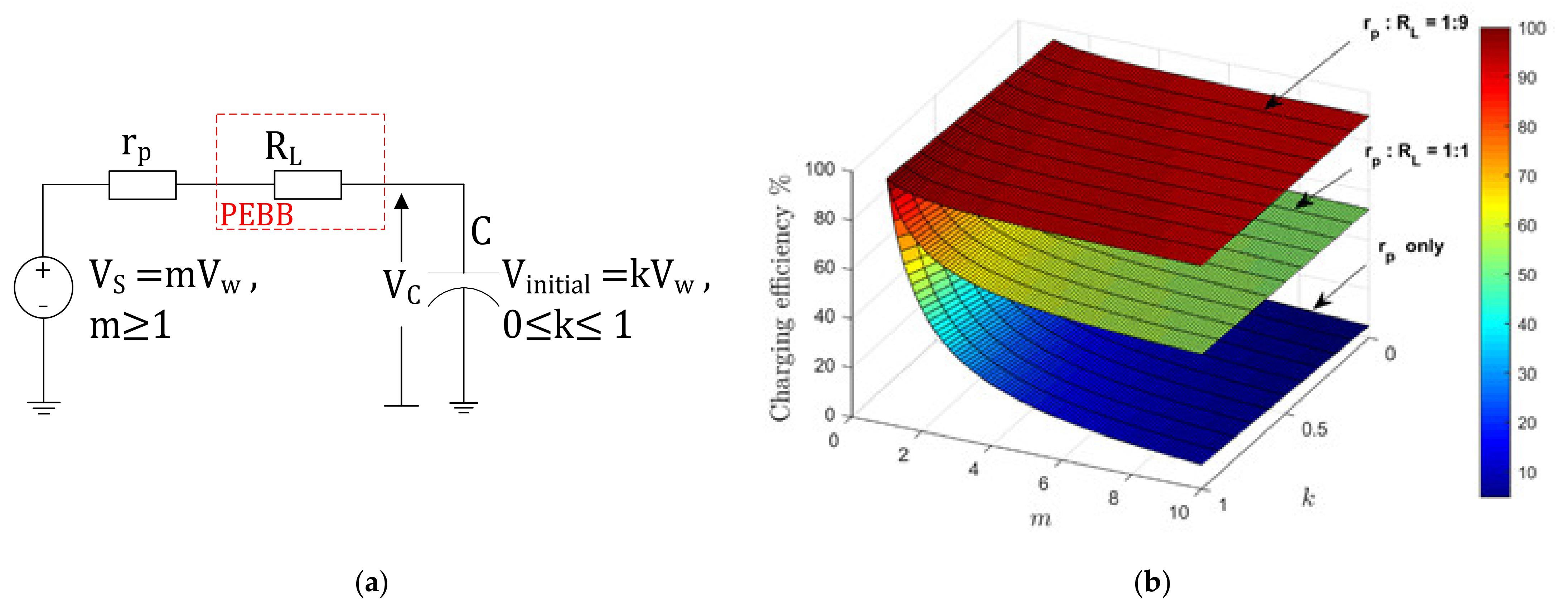

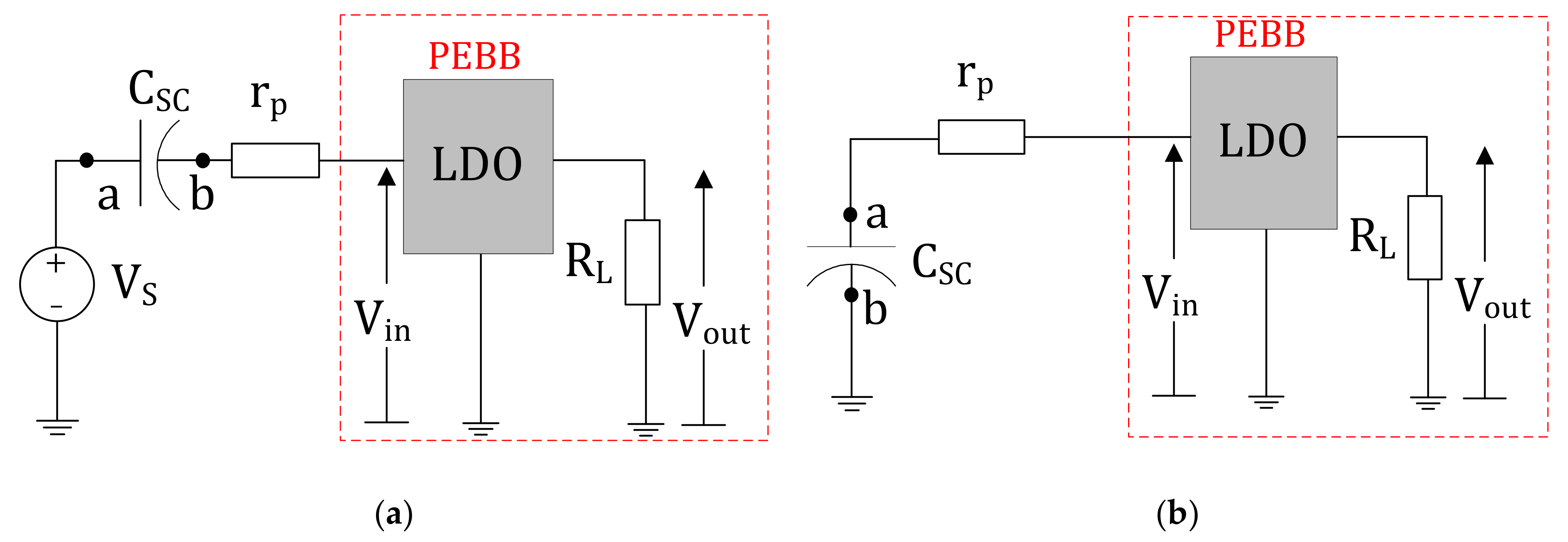

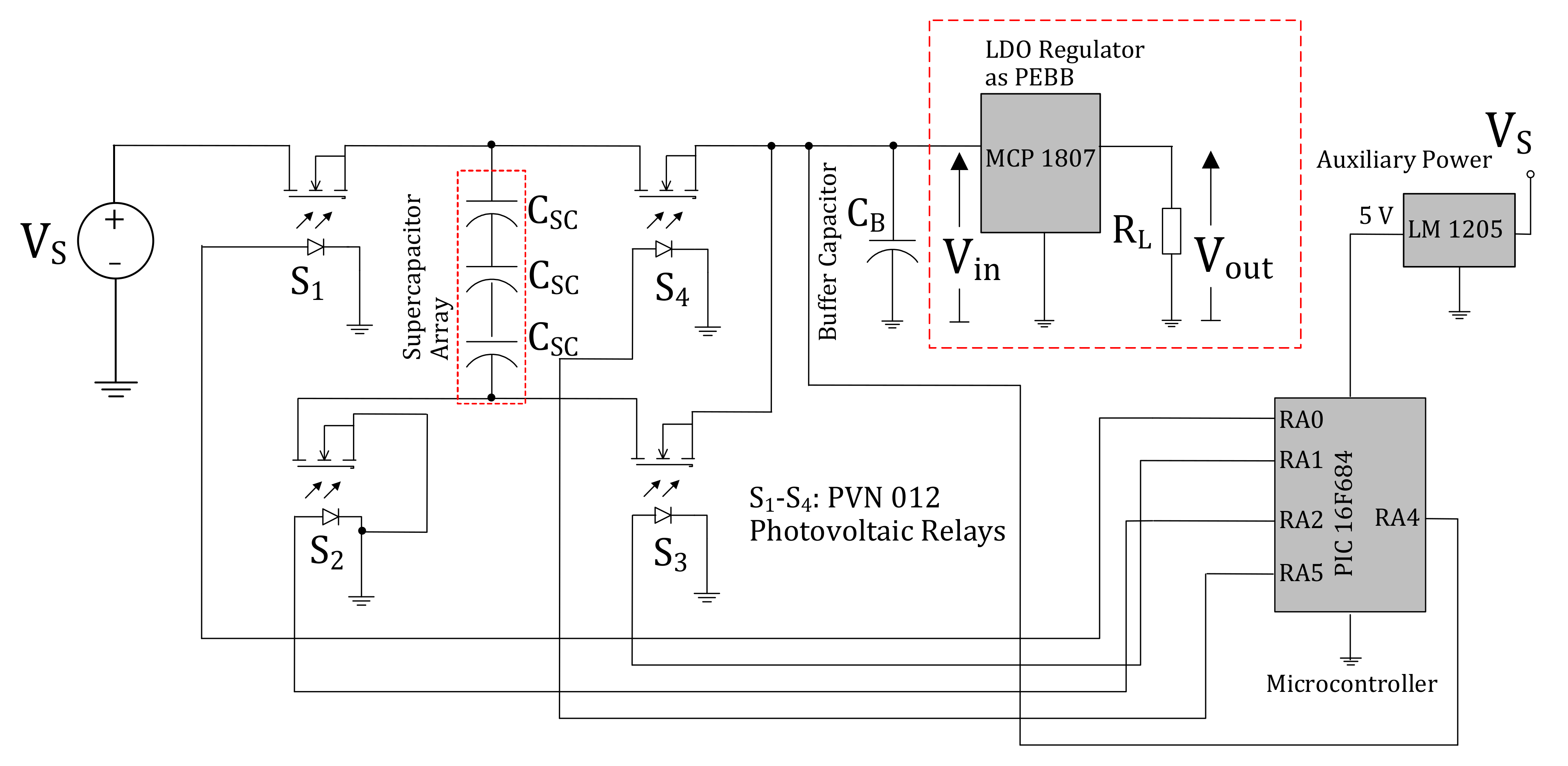
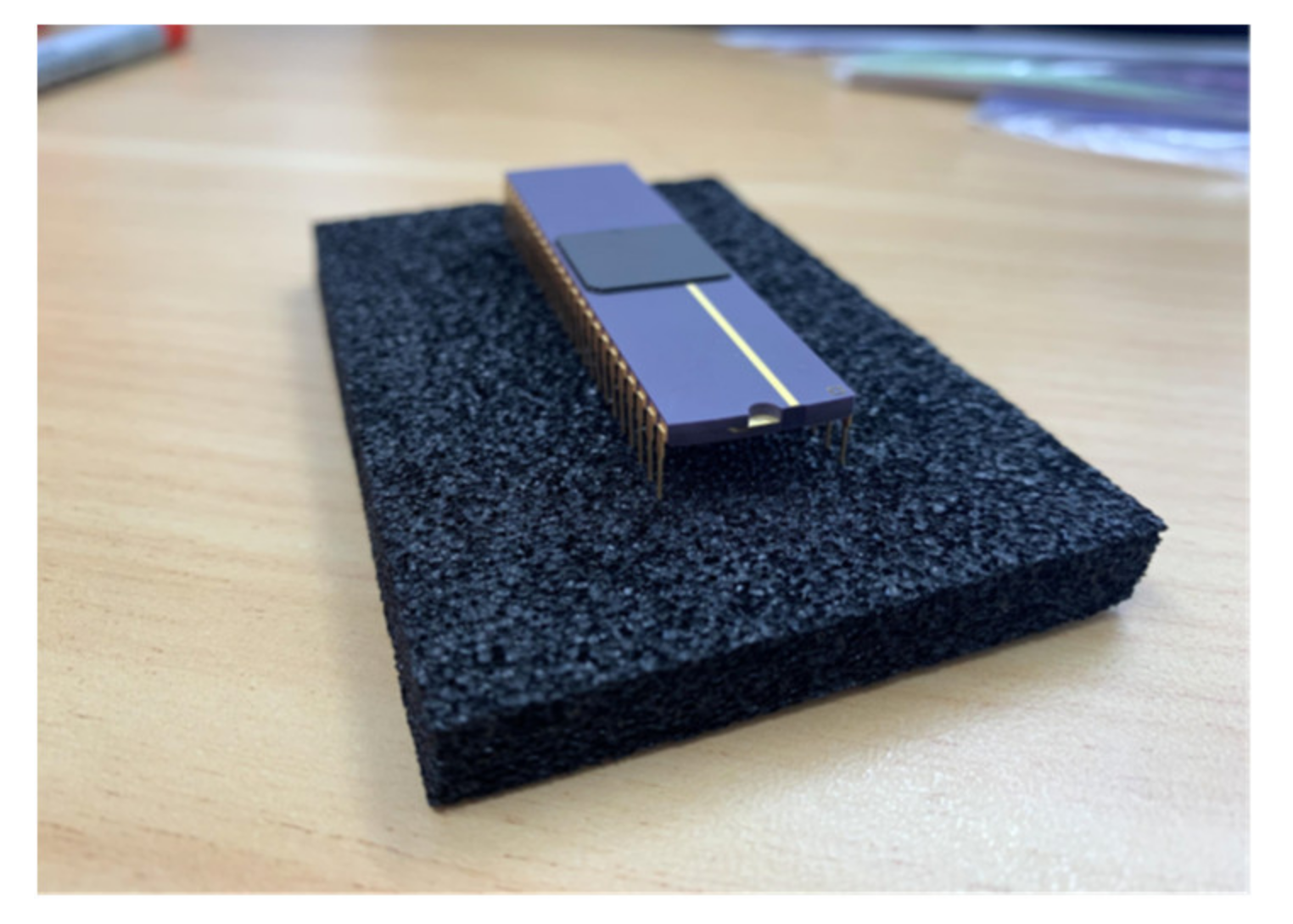

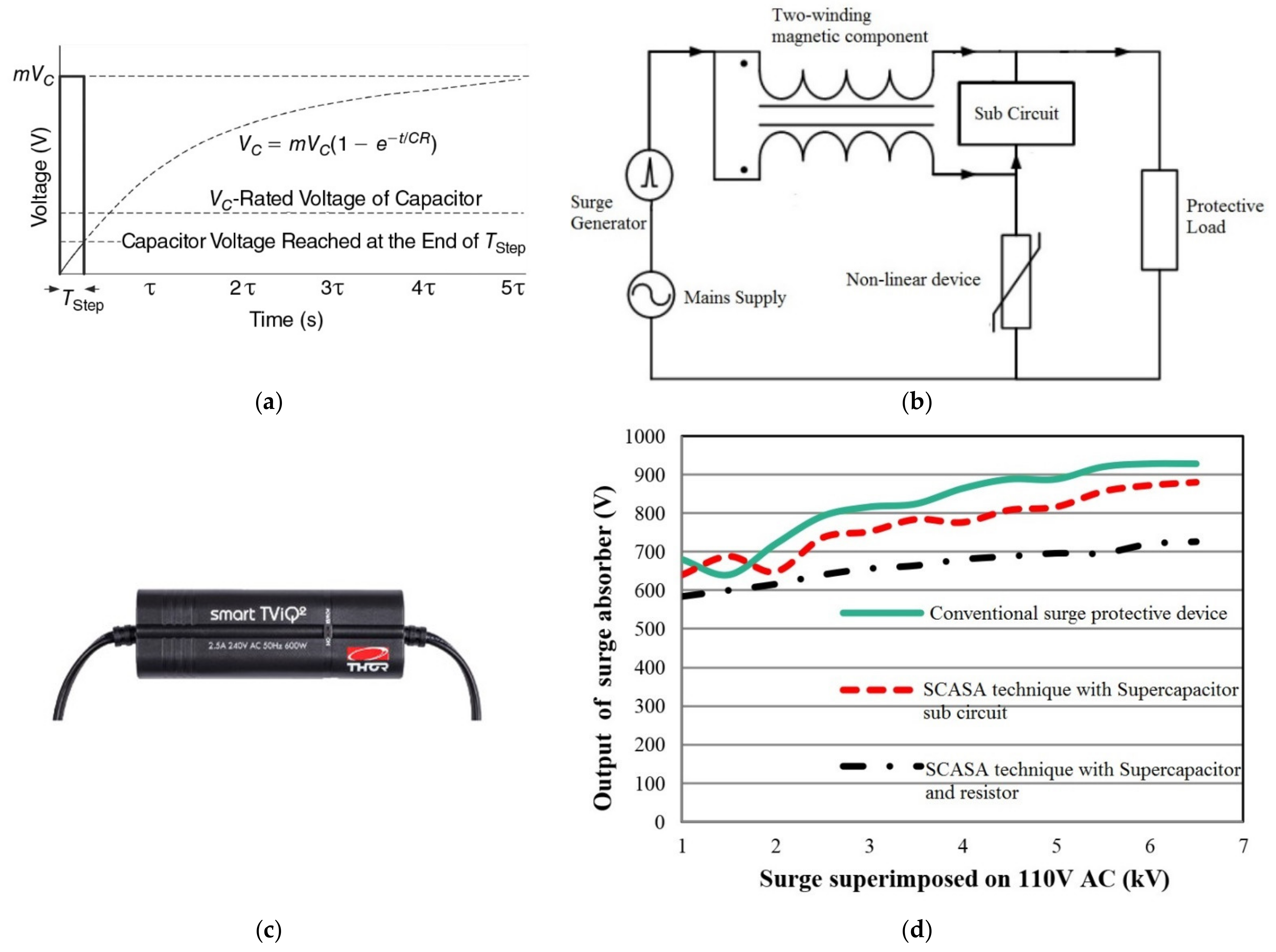
| Characteristics | Capacitors | Supercapacitors | Batteries |
|---|---|---|---|
| Power density (W/kg) | >106 | 32,000 | <1000 |
| Energy density (Wh/kg) | <0.1 | 1 to 20 | 10 to 100 |
| Equivalent series resistance | Typically, in mΩ range | Typically, in mΩ range | Fractional Ω to few Ω |
| Cycle time | 106 | 50,000 to 1,000,000 | 500 to 2000 |
| Charge time (seconds) | 10−3 to 10−6 | 1 to 60 | 3,600 to 18,000 |
| Discharge time (seconds) | 10−3 to 10−6 | 6 to 1800 | 600 to 10,800 |
| Typical lifetime (years) | 30 | 30 | 5 |
| Operating temperature range (°C) | −40 to +125 | −40 to +70 | −20 to +65 |
| Parameter | EDLC | Hybrid Supercapacitor | Pseudocapacitor |
|---|---|---|---|
| Storage mechanism | Non-faradic/electrostatic, electrical charge stored at the metal/electrolyte interface | Both faradaic and non-faradic | Faradic, reversible redox reaction |
| Maximum Specific Power (W/Kg) | 10,000 | 5000 | 4000 |
| Specific energy (Wh/kg) | 1–20 | 7–12 | 20–60 |
| Life (number of cycles) | 50,000–1000,000 | 40,000–50,000 | 15,000–20,000 |
| Material | Carbon-based materials (e.g., activated carbon, carbon nanotubes) | Metal oxide/carbon-based materials, conducting polymer/carbon-based materials (e.g., Ni(OH)2/rGO, PANI/rGO) | Metal oxides, conducting polymers (e.g., NiO, MgO, PANI) |
| Temperature range (°C) | −40 to 70 | −20 to 60 | −20 to 50 |
| Feature | Conventional Topologies | SCALDO Regulator | ||
|---|---|---|---|---|
| Linear Regulators and LDOs | Switched Capacitor Converters | Switch-Mode Converters | ||
| Conversion type | Step-down | Step-up/down | Step-up/down | Step-down |
| Efficiency | Low to moderate | Moderate to high | Highest | High (can be increased to match switch-mode converters) |
| Cost | Low | Moderate | Moderate | Much lower than switch-mode converters |
| Design complexity | Low | Moderate | Moderate to high | Low |
| External components | Minimum external components | Low | High | Low |
| Noise/EMI | Lowest | Moderate | Highest | Low |
Publisher’s Note: MDPI stays neutral with regard to jurisdictional claims in published maps and institutional affiliations. |
© 2021 by the authors. Licensee MDPI, Basel, Switzerland. This article is an open access article distributed under the terms and conditions of the Creative Commons Attribution (CC BY) license (https://creativecommons.org/licenses/by/4.0/).
Share and Cite
Kularatna, N.; Subasinghage, K.; Gunawardane, K.; Jayananda, D.; Ariyarathna, T. Supercapacitor-Assisted Techniques and Supercapacitor-Assisted Loss Management Concept: New Design Approaches to Change the Roadmap of Power Conversion Systems. Electronics 2021, 10, 1697. https://doi.org/10.3390/electronics10141697
Kularatna N, Subasinghage K, Gunawardane K, Jayananda D, Ariyarathna T. Supercapacitor-Assisted Techniques and Supercapacitor-Assisted Loss Management Concept: New Design Approaches to Change the Roadmap of Power Conversion Systems. Electronics. 2021; 10(14):1697. https://doi.org/10.3390/electronics10141697
Chicago/Turabian StyleKularatna, Nihal, Kasun Subasinghage, Kosala Gunawardane, Dilini Jayananda, and Thilanga Ariyarathna. 2021. "Supercapacitor-Assisted Techniques and Supercapacitor-Assisted Loss Management Concept: New Design Approaches to Change the Roadmap of Power Conversion Systems" Electronics 10, no. 14: 1697. https://doi.org/10.3390/electronics10141697
APA StyleKularatna, N., Subasinghage, K., Gunawardane, K., Jayananda, D., & Ariyarathna, T. (2021). Supercapacitor-Assisted Techniques and Supercapacitor-Assisted Loss Management Concept: New Design Approaches to Change the Roadmap of Power Conversion Systems. Electronics, 10(14), 1697. https://doi.org/10.3390/electronics10141697







